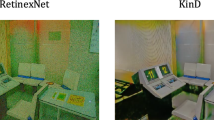Abstract
Images captured in low-light environments often suffer from complex degradation. Simply adjusting light would inevitably result in burst of hidden noise and color distortion. To seek results with satisfied lighting, cleanliness, and realism from degraded inputs, this paper presents a novel framework inspired by the divide-and-rule principle, greatly alleviating the degradation entanglement. Assuming that an image can be decomposed into texture (with possible noise) and color components, one can specifically execute noise removal and color correction along with light adjustment. For this purpose, we propose to convert an image from the RGB colorspace into a luminance-chrominance one. An adjustable noise suppression network is designed to eliminate noise in the brightened luminance, having the illumination map estimated to indicate noise amplification levels. The enhanced luminance further serves as guidance for the chrominance mapper to generate realistic colors. Extensive experiments are conducted to reveal the effectiveness of our design, and demonstrate its superiority over state-of-the-art alternatives both quantitatively and qualitatively on several benchmark datasets. Our code has been made publicly available at https://github.com/mingcv/Bread.

















Similar content being viewed by others
References
Abdullah-Al-Wadud, M., Kabir, M. H., Dewan, M. A. A., & Chae, O. (2007). A dynamic histogram equalization for image contrast enhancement. IEEE Transactions on Consumer Electronics, 53(2), 593–600.
Brooks, T., Mildenhall, B., Xue, T., Chen, J., Sharlet, D. & Barron, J. T. (2019) Unprocessing images for learned raw denoising. In CVPR, pages 11036–11045
Cai, J., Shuhang, G., & Zhang, L. (2018). Learning a deep single image contrast enhancer from multi-exposure images. IEEE TIP, 27(4), 2049–2062.
Celik, T., & Tjahjadi, T. (2011). Contextual and variational contrast enhancement. IEEE TIP, 20(12), 3431–3441.
Chen, C., Chen, Q., Xu, J., & Koltun, V.. (2018) Learning to see in the dark. In: CVPR, pages 3291–3300
Cheng, H.-D., & Shi, X. J. (2004). A simple and effective histogram equalization approach to image enhancement. Digital signal processing, 14(2), 158–170.
Dabov, K., Foi, A., Katkovnik, V., & Egiazarian, K. O. (2007). Image denoising by sparse 3-d transform-domain collaborative filtering. IEEE TIP, 16(8), 2080–2095.
Fan, M., Wang, W., Yang, W., & Liu, J. (2020) Integrating semantic segmentation and retinex model for low-light image enhancement. In ACM MM, pages 2317–2325
Fang, Y., Zhu, H., Ma, K., Wang, Z., & Li, S. (2020). Perceptual evaluation for multi-exposure image fusion of dynamic scenes. IEEE TIP, 29, 1127–1138.
Fu, X., Zeng, D., Huang, Y., Zhang, X.-P. & Ding, X. (2016) A weighted variational model for simultaneous reflectance and illumination estimation. In CVPR, pages 2782–2790
Ge, Z., Liu, S., Wang, F., Li, Z., & Sun, J. (2021) Yolox: Exceeding yolo series in 2021. arXiv preprint arXiv:2107.08430
Guo, C., Li, C., Guo, J., Loy, C. C., Hou, J., Kwong, S., & Cong, R. (2020) Zero-reference deep curve estimation for low-light image enhancement. In CVPR, pages 1780–1789
Guo, X., Li, Y., & Ling, H. (2016). Lime: Low-light image enhancement via illumination map estimation. IEEE TIP, 26(2), 982–993.
Ignatov, A., Van Gool, L., & Timofte, R.. (2020) Replacing mobile camera isp with a single deep learning model. In CVPR, pages 536–537.
Jiang, Y., Gong, X., Ding Liu, Yu., Cheng, C. F., Shen, X., Yang, J., et al. (2021). Enlightengan: Deep light enhancement without paired supervision. IEEE TIP, 30(2), 2340–2349.
Jobson, D. J., Rahman, Z., & Woodell, G. A. (1997). A multiscale retinex for bridging the gap between color images and the human observation of scenes. IEEE TIP, 6(7), 965–976.
Jobson, D. J., Rahman, Z., & Woodell, G. A. (1997). Properties and performance of a center/surround retinex. IEEE TIP, 6(3), 451–462.
Kun, L., & Zhang, L. (2020). Tbefn: A two-branch exposure-fusion network for low-light image enhancement. IEEE TMM, 23(2), 4093–4105.
Land, E. H. (1977). The retinex theory of color vision. Scientific american, 237(6), 108–129.
Lee, C., Lee, C., & Kim, C.-S. (2013). Contrast enhancement based on layered difference representation of 2d histograms. IEEE TIP, 22(12), 5372–5384.
Li, C., Guo, J., Porikli, F., & Pang, Y. (2018). Lightennet: A convolutional neural network for weakly illuminated image enhancement. Pattern recognition letters, 104(2), 15–22.
Li, J., Li, J., Fang, F., Li, F., & Zhang, G. (2020). Luminance-aware pyramid network for low-light image enhancement. IEEE TMM, 23(2), 3153–3165.
Li, M., Liu, J., Yang, W., Sun, X., & Guo, Z. (2018). Structure-revealing low-light image enhancement via robust retinex model. IEEE TIP, 27(6), 2828–2841.
Lim, S., & Kim, W. (2020). Dslr: Deep stacked laplacian restorer for low-light image enhancement. IEEE TMM, 23(2), 4272–4284.
Lin, S., Ryabtsev, A., Sengupta, S., Curless, B. L., Seitz, S. M. & Kemelmacher-Shlizerman, I. (2021) Real-time high-resolution background matting. In CVPR, pages 8762–8771
Liu, Z., Li, X., Luo, P., Loy, C. C., & Tang, X. (2017). Deep learning markov random field for semantic segmentation. IEEE TPAMI, 40(8), 1814–1828.
Lore, K. G., Akintayo, A., & Sarkar, S. (2017). Llnet: A deep autoencoder approach to natural low-light image enhancement. PR, 61(2):650–662
Mittal, A., Soundararajan, R., & Bovik, A. C. (2013). Making a completely blind image quality analyzer. IEEE Signal Processing Letters, 20(2), 209–212.
Pisano, E. D., Zong, S., Hemminger, B. M., Marla DeLuca, R., Johnston, E., Keith Muller, M., et al. (1998). Contrast limited adaptive histogram equalization image processing to improve the detection of simulated spiculations in dense mammograms. Journal of Digital imaging, 11(4), 193.
Ren, W., Liu, S., Ma, L., Qianqian, X., Xiangyu, X., Cao, X., et al. (2019). Low-light image enhancement via a deep hybrid network. IEEE TIP, 28(9), 4364–4375.
Schwartz, E., Giryes, R., & Bronstein, A. M. (2018). Deepisp: Toward learning an end-to-end image processing pipeline. IEEE TIP, 28(2), 912–923.
Sharma, G., Wencheng, W., & Dalal, E. N. (2005). The ciede2000 color-difference formula: Implementation notes, supplementary test data, and mathematical observations. Color Research and Application, 30(2), 21–30.
Shen, L., Yue, Z., Feng, F., Chen, Q., Liu, S., & Ma, J. (2017) Msr-net: Low-light image enhancement using deep convolutional network. arXiv preprint arXiv:1711.02488
Tan, M., Pang, R., & Le, Q. V. (2020) Efficientdet: Scalable and efficient object detection. In CVPR, pages 10781–10790
Wang, Y., Cao, Y., Zha, Z.-J., Zhang, J., Xiong, Z., Zhang, W., & Wu, F. (2019) Progressive retinex: Mutually reinforced illumination-noise perception network for low-light image enhancement. In ACM MM, pages 2015–2023
Wang, W., Wei, C., Yang, W., & Liu, Jiaying. (2018) Gladnet: Low-light enhancement network with global awareness. In IEEE International Conference on Automatic Face & Gesture Recognition, pages 751–755
Wang, R., Zhang, Q., Fu, C.-W., Shen, X., Zheng, W.-S. & Jia J. (2019) Underexposed photo enhancement using deep illumination estimation. In CVPR, pages 6849–6857
Wang, L.-W., Liu, Z.-S., Siu, W.-C., & Lun, D. P. K. (2020). Lightening network for low-light image enhancement. IEEE TIP, 29(2), 7984–7996.
Wang, S., Zheng, J., Hai-Miao, H., & Li, B. (2013). Naturalness preserved enhancement algorithm for non-uniform illumination images. IEEE TIP, 22(9), 3538–3548.
Wei, C., Wang, W., Yang, W. & Liu, J. (2018) Deep retinex decomposition for low-light enhancement. In BMVC, page 155
Xu, Ke, Yang, Xin, Yin, Baocai, & Lau, Rynson WH. (2020) Learning to restore low-light images via decomposition-and-enhancement. In CVPR, pages 2281–2290
Yang, J., Jiang, X., Pan, C., & Liu, C. L. (2016) Enhancement of low light level images with coupled dictionary learning. In ICPR, pages 751–756
Yang, W., Wang, S., Fang, Y., Wang, Y., & Liu, J. (2020) From fidelity to perceptual quality: A semi-supervised approach for low-light image enhancement. In CVPR, pages 3063–3072
Yang, W., Wang, W., Huang, H., Wang, S., & Liu, J. (2021). Sparse gradient regularized deep retinex network for robust low-light image enhancement. IEEE TIP, 30(2), 2072–2086.
Zhang, Y., Zhang, J. & Guo, X. (2019).Kindling the darkness: A practical low-light image enhancer. In ACM MM, pages 1632–1640
Zhang, L., Zhang, L., Liu, X., Shen, Y., Zhang, S., & Zhao, S. (2019). Zero-shot restoration of back-lit images using deep internal learning. In ACM MM, pages 1623–1631
Zhang, Y., Guo, X., Ma, J., Liu, W., & Zhang, J. (2021). Beyond brightening low-light images. IJCV, 129(4), 1013–1037.
Zhang, K., Zuo, W., Chen, Y., Meng, D., & Zhang, L. (2017). Beyond a gaussian denoiser: Residual learning of deep cnn for image denoising. IEEE TIP, 26(7), 3142–3155.
Zhu, M., Pan, P., Chen, W. & Yang, Y. (2020). Eemefn: Low-light image enhancement via edge-enhanced multi-exposure fusion network. In AAAI, pages 13106–13113
Acknowledgements
The authors would like to thank the editors and reviewers for their effort in handling our submission, as well as the comments and suggestions that improve the quality of this paper. This work was supported by the National Natural Science Foundation of China under Grant no. 62072327.
Author information
Authors and Affiliations
Corresponding author
Additional information
Communicated by Yu Li.
Publisher's Note
Springer Nature remains neutral with regard to jurisdictional claims in published maps and institutional affiliations.
Rights and permissions
Springer Nature or its licensor (e.g. a society or other partner) holds exclusive rights to this article under a publishing agreement with the author(s) or other rightsholder(s); author self-archiving of the accepted manuscript version of this article is solely governed by the terms of such publishing agreement and applicable law.
About this article
Cite this article
Guo, X., Hu, Q. Low-light Image Enhancement via Breaking Down the Darkness. Int J Comput Vis 131, 48–66 (2023). https://doi.org/10.1007/s11263-022-01667-9
Received:
Accepted:
Published:
Issue Date:
DOI: https://doi.org/10.1007/s11263-022-01667-9




